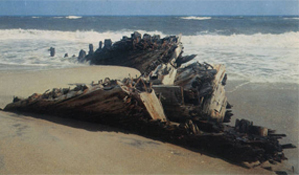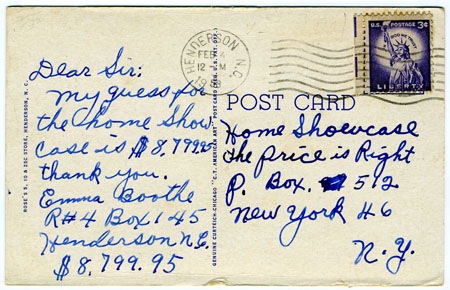 Seemingly a simple street view of Henderson, NC, this postcard was mailed to New York City in 1958 bearing one Hendersonian’s guess for The Price is Right’s Home Showcase contest. Thinking about consumer society and the explosion of mass-marketed home appliances and electronics during the 1950s, I’d be curious to know what item she was bidding over eight thousand dollars on – and how much it would cost today!
Seemingly a simple street view of Henderson, NC, this postcard was mailed to New York City in 1958 bearing one Hendersonian’s guess for The Price is Right’s Home Showcase contest. Thinking about consumer society and the explosion of mass-marketed home appliances and electronics during the 1950s, I’d be curious to know what item she was bidding over eight thousand dollars on – and how much it would cost today!
Category: Postcards
Where The Heel?, Part VI
University Of North Carolina At Durham?
UNC and Duke partisans shouldn’t be too hard on the two skydivers from Virginia-based Aerial Adventures who recently mistook Duke’s Wallace Wade Stadium for Kenan Stadium in Chapel Hill, eight miles away. After all, they are not the first to have confused the two institutions.
Hired to deliver the game ball for UNC’s August 30th season-opening football contest with McNeese State, the parachutists declined to jump because of bad weather when they passed over Kenan. A few minutes later the clouds broke. The men saw a stadium below, assumed they were again over Kenan, and jumped—to the confusion and then delight of Duke fans gathered for pre-game ceremonies.
Confusing UNC and Duke is simply inconceivable to alumni and fans of the two fierce rivals. But it does occasionally happen and not just among parachutists. Shortly after Caldwell Hall was dedicated on the UNC campus in 1912, the S. H. Kress & Co., published this postcard, which identified the building as being on the University of North Carolina campus—in Durham.
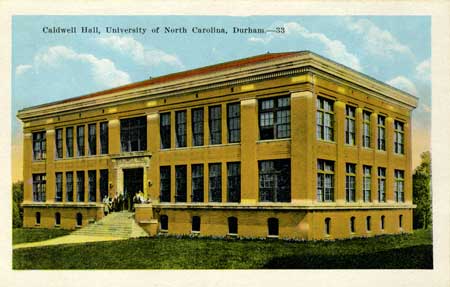
Rock Springs Camp Meeting
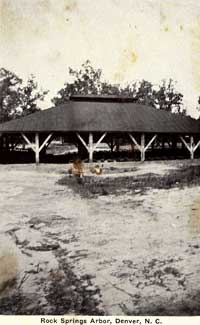 At the end of July 2008 thousands of people gathered in Denver, North Carolina, for the annual Rock Springs Camp Meeting. The oldest continuing camp meeting in North Carolina, Rock Springs traces its roots to a meeting held at Rehobeth Methodist Church in Lincoln County in 1794. Camp meetings grew out of the isolation of life in a frontier area and the strong revival spirit of protestant Christianity. Often churches of different denominations would combine to sponsor the meeting, and families would come from miles around to the campground for a series of preaching and singing events which lasted from several days to a couple of weeks. Some families have been returning to the same tents – actually small cabins – at Rock Springs for generations. The accompanying illustration, from our post card collection, shows the permanent “arbor” at Rock Springs. [Thanks to loyal NCM reader Kevin Cherry for this suggestion.]
At the end of July 2008 thousands of people gathered in Denver, North Carolina, for the annual Rock Springs Camp Meeting. The oldest continuing camp meeting in North Carolina, Rock Springs traces its roots to a meeting held at Rehobeth Methodist Church in Lincoln County in 1794. Camp meetings grew out of the isolation of life in a frontier area and the strong revival spirit of protestant Christianity. Often churches of different denominations would combine to sponsor the meeting, and families would come from miles around to the campground for a series of preaching and singing events which lasted from several days to a couple of weeks. Some families have been returning to the same tents – actually small cabins – at Rock Springs for generations. The accompanying illustration, from our post card collection, shows the permanent “arbor” at Rock Springs. [Thanks to loyal NCM reader Kevin Cherry for this suggestion.]
Where The Heel?, Part III
It’s been too long since our last edition of “Where The Heel?,” so I picked (what I believe to be) a tough one.
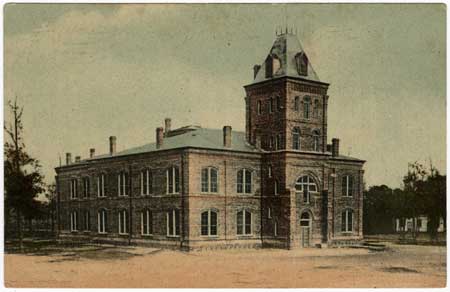
Can you identify this building? Can you tell me where in North Carolina it is? (By the way, it is still standing.) If you have a guess, leave it in the comments for this post. We’ll let you know if you are correct!
Hilfe!
Part of my job with the North Carolina Postcards project is to describe the postcards, including the messages written on them. Today I came across this Durham postcard, and you’ll notice that the message is written in German. Suffering a severe unfamiliarity with the language, I am having trouble transcribing it, and am wondering if any of you folks out there can help!
While a translation would be quite interesting, what we need most is an actual transcription of the message in German.
Any help?
Where The Heel?
The North Carolina Collection is a treasure trove of interesting and fun items (as well as an excellent research library–if we do say so ourselves). As a way of sharing some of these items, we are starting a “Where The Heel?” contest. Inspired by a similar feature in a 1937 issue of The State magazine (now Our State), every so often we’ll post a blog entry asking you, our readers, if you can identify a certain town. Though The State offered their winners a $10 prize (during the Great Depression, no less!), we can only promise you glory and honor.
To get things started, can you identify this city (ca. 1930-1945)? Leave a comment, and watch for us to comment back once we have a winner.
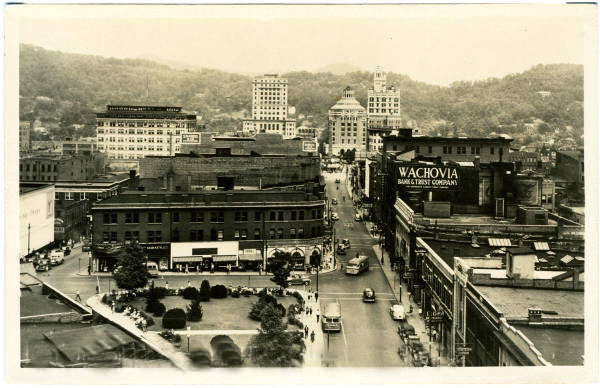
Charlotte Speedway, Ghost Track of the Carolinas
One of the greatest mysteries I’ve encountered here in the North Carolina Collection has revolved around this postcard of “Charlotte Speedway:”
Curious about this predecessor to today’s Lowes Motor Speedway, I sleuthed around a bit to learn more about the track. What I found was perplexing: most sources described Charlotte Speedway as a dirt track built near the old airport in 1949, where stock car races were held. And yet, pictured here was an indy race on a wooden track, and the card appeared to be much older than 1949. I kept searching for traces of the speedway, to no avail. It seemed that maybe this indy track had been utterly forgotten here in stock car country.
Months have passed since my initial investigation, but today while browsing the index to “The State” magazine, I spotted this listing: “First Speedway Race Track.” Though I expected this lead would end up yet another reference the 1949 stock car track, I had to give it a shot. When I opened that November 1979 issue, I saw it: an image of a wooden track identical to the one pictured in the postcard.
Sure enough, there was another Charlotte Speedway built in Pineville in 1924, where indy races were held. According to the brief article by Bugs Barringer, the track was made of green pine two by fours, so that the wood would cure and shrink, allowing ventilation between the boards and preventing the tires from burning during races. Apparently a few stock car races were held at the track but, ironically, they attracted too few spectators to be profitable.
Vanished: New Feature on NC Postcards
From training camps, to parks, to opera houses: Vanished North Carolina features images from North Carolina Postcards of selected historic places that no longer exist. Use the interactive map to zoom in to each historic site and see what’s there today. You can find Vanished North Carolina along with our other special features on the Browse by Subject page.
The G. A. Kohler
A 1933 hurricane pushed the G. A. Kohler, a four-masted schooner from Baltimore, ashore just north of Cape Hatteras. The wreck remained on the coast until World War II, when the wooden ship was burned in an effort to recover scrap iron from her hull. The image of the intact ship was made sometime between the wreck and 1945.
<img src='https://blogs.lib.unc.edu/ncm/wp-content/uploads/sites/6/2007/11/kohler_together.jpg' alt='kohler_together.jpg' align="center" vspace="8" hspace="14"
The color image, which comes from a postcard in the Durwood Barbour Collection, is not dated but is thought to have been created in the 1950s or 1960s.





